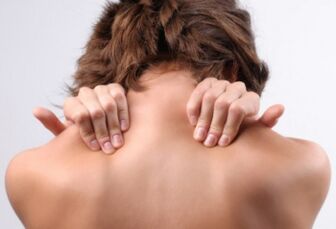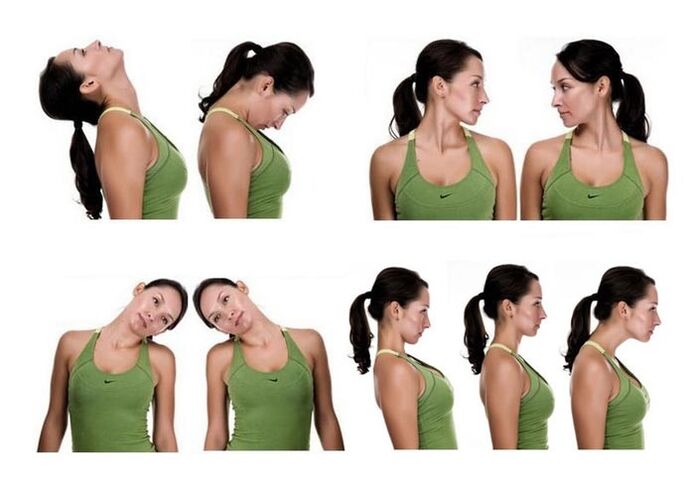
Few modern people have ever heard of osteochondrosis. Most of them experienced the symptoms of this disease on several occasions. The wide spread of the disease is associated with long sitting at the computer, passive lifestyle, poor diet, etc. Cervical spine osteochondrosis presents with pain, muscle weakness, limited mobility, and a host of other symptoms.
Don't ignore the signs of osteochondrosis, because the sooner you start treatment, the faster you'll get rid of the disease. In the initial stages, conservative therapy is performed: taking medication, exercise therapy, physiotherapy, massage, etc. When complications and destruction of the bone-cartilaginous structure arise, an operation is prescribed.
What is that
Neck osteochondrosis is a condition that occurs only in humans. Animals don't suffer from it. This is due to the vertical position of the spine. In this position, the vertebrae compress, which leads to the gradual destruction of the intervertebral discs.
The cervical region is made up of 7 vertebrae, which are separated from each other by discs. This segment of the spine is quite mobile, which is why it is one of the most vulnerable areas of the spine. The weakest link in the cervical spine is the intervertebral disc, which mainly reflects degenerative dystrophic changes.
The prevalence of cervical osteochondrosis is also explained by a weak muscular corset in the neck. Also, small vertebrae are located in this area, they have a different structure and they fit together very well. For this reason, a small load on the neck can cause its displacement, as well as compression of blood vessels and nerve branches. When the vertebral artery is clamped, located within the spine in this area, dangerous complications arise.
Osteochondrosis of the cervical spine (SC) threatens with protrusions (displacement of the nucleus pulposus without damaging the outer shell) and herniated disc. These formations compress nerve bundles, blood vessels.
Due to degenerative changes in the intervertebral discs, the likelihood of bone growths (osteophytes) in the joint areas of the vertebrae increases. Because of this, the intervertebral canal narrows and the neurovascular formations are compressed.
Reference. According to medical statistics, people over the age of 35 are more likely to suffer from cervical osteochondrosis. Although there is now a rejuvenation of the pathology, it usually develops in patients from 20 years of age onwards. This is due to a predominantly sedentary lifestyle and poor diet.
Doctors identified 4 stages of the pathology:
- 1st degree - the cartilaginous lining between the vertebrae begins to collapse. At this stage, the disease eliminated the symptoms. Unfortunately, patients don't notice them.
- 2 degrees - under pressure from the vertebrae, the height of the disc decreases, the integrity of its outer shell is violated. At this stage, bumps may appear. Pain appears, neck mobility is limited, and facial sensitivity may be impaired.
- Grade 3 - the protrusions turn into hernias, which compress blood vessels and muscles. In addition to the pain syndrome, there is pain in the back of the neck, dizziness.
- 4 degrees - osteophytes form, which stabilize the vertebrae but compress the nerve fibers. The pain does not go away, rigidity of movement occurs, the neighboring vertebrae are damaged and neurological symptoms appear.
It is important to start treatment at stages 1 - 2 to avoid serious complications that can only be corrected by surgery.
causes
Osteochondrosis SHOP is a complex and time-consuming process that can occur under the influence of many negative factors.
For example, in elderly people, the disease is associated with age-related changes in the body. Then, degenerative dystrophic changes occur as a result of interruption of local blood circulation, metabolic processes, weakening of immunity.
However, doctors have identified the main causes of cervical osteochondrosis:
- Poor posture.
- Spinal curvature.
- Cervical segment injuries.
- Excessive weight.
- Exhaustive physical work.
- Extended session on the computer.
- Passive lifestyle.
- Violation of metabolic processes.
- Frequent neck hypothermia.
- Inadequate organization of the sleeping place (mattress too soft, pillow high).
- Frequent stress, chronic fatigue.
- Congenital pathologies of the STORE structure.
- Autoimmune diseases that cause cartilage degeneration.
- Infections.
- Characteristics of body parts such as very long or short neck.
Under the influence of these factors, intervertebral structures, bone tissues start to collapse, nerve bundles and blood vessels are damaged.
Symptoms
The clinical picture of cervical spine osteochondrosis (OSHOP) is diverse. For this reason, it is difficult for patients to understand what is happening to them. They attribute the first manifestations of the disease to overwork. And after the onset of more pronounced symptoms, they run to the doctor, but in this case, the irreversible changes are already present and it will no longer be possible to restore the structure of the cervical spine.

The main symptoms of osteochondrosis of the cervical spine:
- Painful sensations in neck, shoulders.
- Weakening of the muscles around the affected segment of the spine.
- Excessive sweating.
- Violation of upper limb sensitivity.
- Motor coordination disorders.
- Headache (headache).
- Vertigo (dizziness).
- Disorders of hearing and vision.
- Increased blood pressure, etc.
The nature of headache in osteochondrosis is different: paroxysmal, constant, pulsating, opaque. This symptom is manifested by spasm of the cerebral vessels, compression of the nerve bundles in the cervical spine, and increased intracranial pressure.
With OSHOP, pain does not always appear in the region of the cervical segment, it can spread to the shoulders and arms. Discomfort after sleep, sudden movements, tension in the neck, for example, when coughing or sneezing may occur.
With SHOP osteochondrosis, pressure peaks are observed depending on the time of day, constant hypertension is not characteristic of the pathology. Usually, with increased pressure, the following manifestations are observed: headache, pain in the hands, numbness in the area of the cervical collar. Pressure drops are often seen after nervous or muscle tension, prolonged uncomfortable posture.
Cervical osteochondrosis syndromes
Several syndromes (typical conditions accompanied by characteristic symptoms) are seen in OSHOP. Its manifestation depends on which nerve branches and vessels are damaged.
Cervical osteochondrosis syndromes:
- Vertebral artery - Occurs as a result of compression or irritation of an artery that feeds the brain. Then the patient suffers from hearing impairment, vision, dizziness, pressure drops, migraines, etc.
- Cardiac - develops when the nerve bundles that innervate the diaphragm or pectoralis muscle are compressed. Then there is a burning pain in the chest, shortness of breath, weakness, increased heart rate.
- Hypertensive - caused by compression of the veins, making it difficult for blood to flow from the head. Then intracranial pressure increases, the patient suffers from headache, nausea, vomiting.
- Cervical migraine - occurs due to compression of the nerves that surround the vertebral artery. Then there is a painful migraine-like pain in the back of the head. The attack lasts about 10 hours and is usually accompanied by the eruption of vomiting.
- Root is the most common symptom complex in OSHOP. It is caused by compression of one of the nerve bundles in the vertebrae of the cervical segment. If the conduction of 1 - 2 roots of the cervical vertebra is disturbed, the sensation will be disturbed or pain will appear in the back of the head. If 3 pairs are damaged, the tongue goes numb, the area behind the ears makes it difficult for a person to chew food. Inflammation of 4 pairs of roots is accompanied by pain in the collarbone, hiccups, difficulty in swallowing. If the conduction of 5 to 8 pairs of nerve bundles is disturbed, it will be difficult for the patient to move his arms.
Reference. Osteochondrosis of the cervical spine often manifests itself in multiple symptom complexes at the same time, so diagnosis is difficult. So you shouldn't find out for yourself, it's better to get in touch with an expert.
establishing a diagnosis
If you are unsure what to do when suspicious symptoms appear, it is best to contact a therapist right away. If necessary, the doctor will refer you to an orthopedist, vertebrologist, neurologist.
In the diagnostic search, the following instrumental studies are used:
- Radiography.
- Computed tomography or magnetic resonance imaging.
- Electroneuromyography.
All of the above studies provide some information about the cervical spine. For example, X-rays, CT scans, MRI scans are used to detect pathological changes in the structure of the spine. Electromyography makes it possible to assess the condition of nerve bundles.
With the aid of radiography, which is performed in different projections, it is possible to detect the accumulation of calcium salts, decreased height of the cartilaginous spacers between the vertebrae, SC deformation, presence of bone protuberances, etc. .
Treatment
OSHOP therapy must be comprehensive. The decision on the choice of technique is made by the physician, taking into account the stage, the form of the disease and the severity of the symptoms.
The treatment of osteochondrosis of the cervical spine is long and complex. It is unlikely that it will be possible to completely cure the pathology, especially when dealing with an elderly patient. However, it is perfectly possible to stop the degenerative dystrophic disorders of the cervical segment at any stage.
In the early stages of the disease, conservative methods are used: medication, corrective gymnastics, physical therapy procedures, massage, orthopedic devices. Most of the above methods can be used at home.
In 3 to 4 stages, which is accompanied by destruction not only of the cartilage but also of the vertebral bodies, surgical intervention may be necessary.
The following medications will help eliminate pain, inflammation, relax tight muscles, and improve the condition of cartilage tissue:
- Analgesics. If the pain is severe, you can help yourself by taking a pain reliever. For the same purpose, NSAIDs are used, which allow you to deal not only with pain, but also with inflammation.
- Steroids prevent inflammation and pain. For that, glucocorticoid-based drugs are used in the form of pills or ointments.
- Muscle relaxants help to relax the spasmodic muscles around the affected area. Therefore, solutions for parenteral administration based on glycerol or benzimidazole are used. They normalize muscle tone and relieve pain.
- Antispasmodics help fight muscle pain and cramps.
- Vitamins speed up nervous system recovery. For this, drugs based on elements of group B, A, C, D, E are administered. The vitamin and mineral complexes are quite effective.
Reference. If the pain syndrome is very severe and oral analgesics don't help, the doctor may prescribe a therapeutic block. Injections using anesthetic solutions or steroids are placed directly at the focus of the pathology. This procedure should only be performed by an experienced technician.
As part of a complex therapy, creams, gels, ointments with anti-inflammatory effects, warmers and analgesics are used.
To alleviate the condition of patients, to improve their physical fitness, therapeutic exercises are prescribed. Exercise helps strengthen the muscles around the neck, improves metabolic processes, speeds up blood circulation, and relieves stress on the weakened spine.
Gymnastics is especially popular at OSHOP, which is usually performed in the gym using special simulators. However, if you wish, you can practice at home.

Exercise Therapy Complex for Cervical Osteochondrosis:
- Gently tilt your head towards your shoulder, lock for 30 seconds and repeat the movement in the other direction.
- Tilt your head forward, trying to rest your chin on your chest, then lift your head slightly forward.
- Lower your head back a little, turn to the right and then to the left shoulder.
- Press your right hand on your left shoulder and lift your elbow slightly. Then turn your head to the right, stop, feeling the muscle tension.
- This exercise is performed like the third one, just by turning your head, raise your arms above your head and interlace them.
- With your hands on your knees, spread them apart, trying to connect your shoulder blades while lifting your chin. Then you will work on the thoracic region.
- Get up, lower your arms, stretch your neck forward, trying to rest your chin on your shoulder.
Before exercising, you need to warm up your joints and take a shower to relax your muscles. After completing the complex, stretch.
You can treat neck osteochondrosis with the help of physical therapy:
- UHF.
- Laser therapy.
- Magnetotherapy.
- Drug electrophoresis, etc.
Magnetotherapy relieves inflammation and pain. UHF and laser treatment speeds up metabolism in the affected area, helps eliminate swelling. Thanks to electrophoresis, drugs penetrate the site of inflammation through the skin, where they immediately show their effect.
With the help of massage, muscle tone is normalized, blood flow to the damaged area is accelerated, and tissue trophism improves. Upon completion of the course, which usually consists of 10 procedures, the development of degenerative dystrophic processes in the cervical spine ceases.
At home, you can use a needle applicator - this is a plastic device with a large number of tips. You need to lie down on the device or apply it to the affected area. The applicator helps relieve pain, relaxes muscles and improves blood circulation and movement.
The Shants Necklace is used when severe pain occurs. This orthopedic appliance secures the neck in the correct position, reduces the load on the vertebrae and relieves pain.
With a complex treatment, the patient will be able to get rid of the degenerative disc disease of the neck for good. However, this is possible if the disease was detected in stage 1. In other cases, complex measures will help to stop the pathology from developing.
Chondrosis of the cervical spine
Many people believe that chondrosis and osteochondrosis are a disease. However, this opinion is wrong. In the first disease, only the cartilaginous lining of the vertebrae is damaged and, in the second, the degenerative changes spread to the bone tissue. In other words, chondrosis is the first stage of osteochondrosis.
Cervical spine chondrosis develops when the metabolic processes of the intervertebral disc are disrupted. Then the collagen fibers are replaced by useless fibrous tissue, the hyaline cartilage calcifies and becomes less elastic. Its height decreases, due to which the function of the vertebrae is impaired.
The causes of chondrosis and osteochondrosis are no different.
Cervical chondrosis has the following symptoms:
- Quick fatigue of the muscles around the STORE.
- Poor posture.
- Recurrent discomfort or mild pain in the affected area.
- Restricted neck mobility.
As a rule, patients do not notice the symptoms of chondrosis. The disease is detected by chance, using an X-ray or MRI.
Chondrosis treatment
The treatment plan for chondrosis of the neck is slightly different from the tactics for treating osteochondrosis. In the first illness, doctors prescribe NSAIDs and chondroprotective drugs. In addition, the patient should avoid excessive physical exertion or sitting for a long time. It is recommended to perform therapeutic exercises, eat well, abandon bad habits.
Additional methods of treatment include massage, manual therapy. In addition, physiotherapy procedures are indicated, eg electrophoresis, ultraviolet irradiation, ampli- tude therapy, diadynamic therapy, balneotherapy, mud treatment. Acupuncture (acupuncture) has proven its effectiveness in treating chondrosis.
Assessments
In most cases, patients are able to get rid of the symptoms of cervical osteochondrosis for a while, then the disease returns. This is usually due to the patient seeking medical care late or not following the doctor's recommendations during treatment. But there are those who managed to cure OSHOP and no longer face its symptoms.
- "I was diagnosed with 2-stage osteochondrosis of the neck. Doctors prescribed anti-inflammatory pills and injections. After the pain wore off, I started massaging, doing special exercises, and putting on a medicinal ointment. After the course of treatment, I felt significant relief. However, after 3 months, the pain in the neck reappeared. Therefore, the course had to be started from the beginning. "
- "I have been living with cervical osteochondrosis for a long time. From time to time, I visit a chiropractor who defines the vertebrae. But physical therapy exercises are the ones that help me the most. The doctor suggested some very effective exercises that I try to do every day. But, as soon as I miss a few classes, the pain starts again. "
- "Early stage cervical osteochondrosis is very treatable. This happened to me. First, doctors prescribed anti-inflammatory therapy, which alleviates pain and inflammation. Then the treatment was complemented by gymnastics, massage, acupuncture. In the pool, I started taking vitamins and eating right. To forget the pain forever, I had to completely change my life. Not a day goes by without special exercise, but the advantage is that nothing hurts me and my fitness has improved. I have not had back pain for a long time and I continue to lead a healthy lifestyle. "
Main conclusions
Cervical spine osteochondrosis is an insidious disease that manifests itself in a variety of symptoms. The patient does not always understand what is really happening to him. And when severe pain appears, he runs to the doctor, but this sign indicates the presence of degenerative-dystrophic changes in the cervical segment. In that case, it will not be possible to restore the spine's condition. Afterwards, the treatment is carried out, which helps to stop the development of the pathology and avoid serious consequences. Osteochondrosis therapy is a complex and time-consuming process that requires patience and organization. After eliminating pain and inflammation, the patient should regularly perform therapeutic exercises, massages, physical therapy procedures, wear orthopedic appliances, eat well, and break bad habits. It's important to lead a healthy lifestyle, observe moderate physical activity, control your weight, and monitor your posture. Only then will you be able to stop the pathology and live a full life.

















































